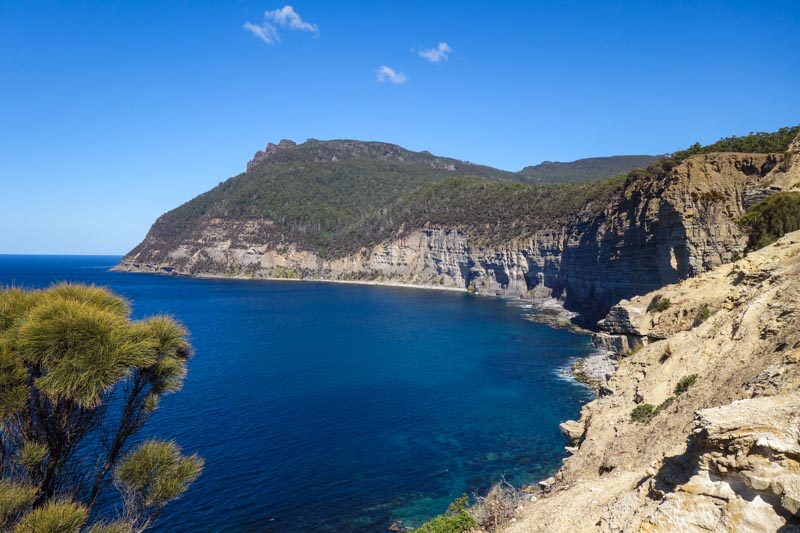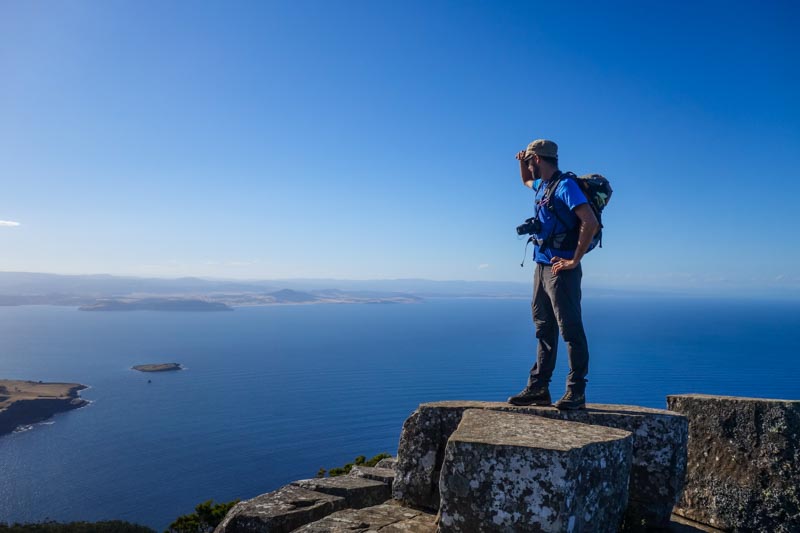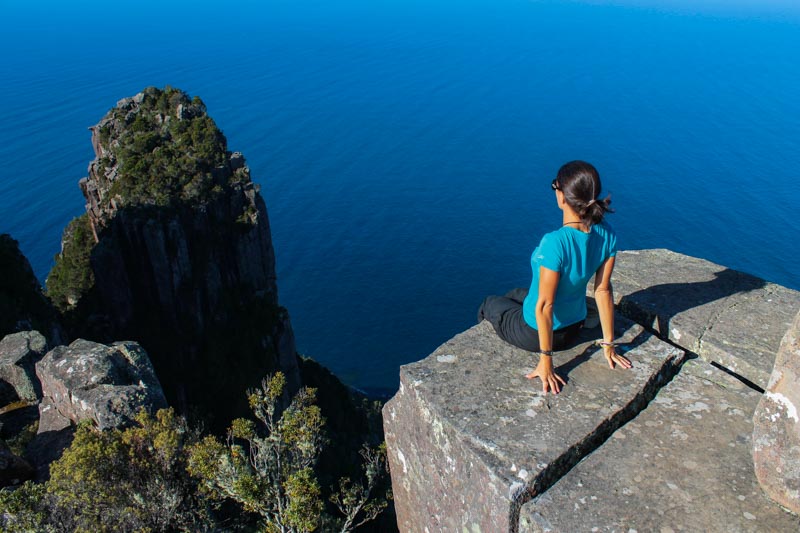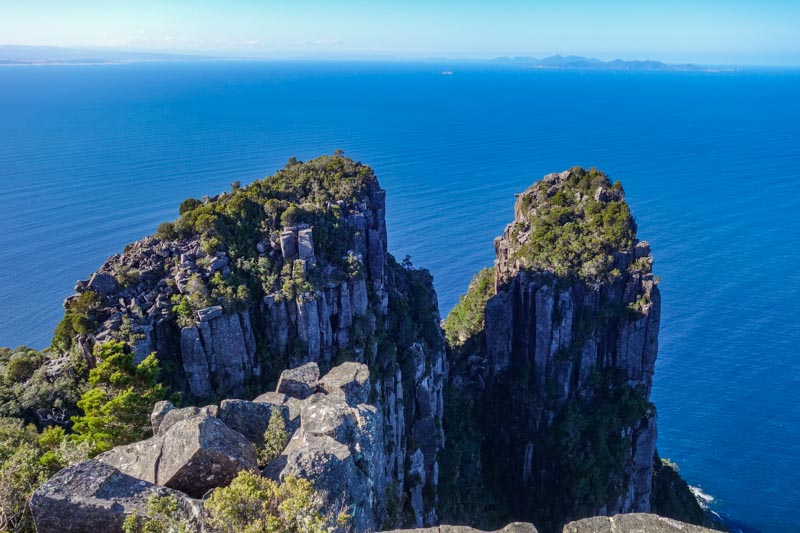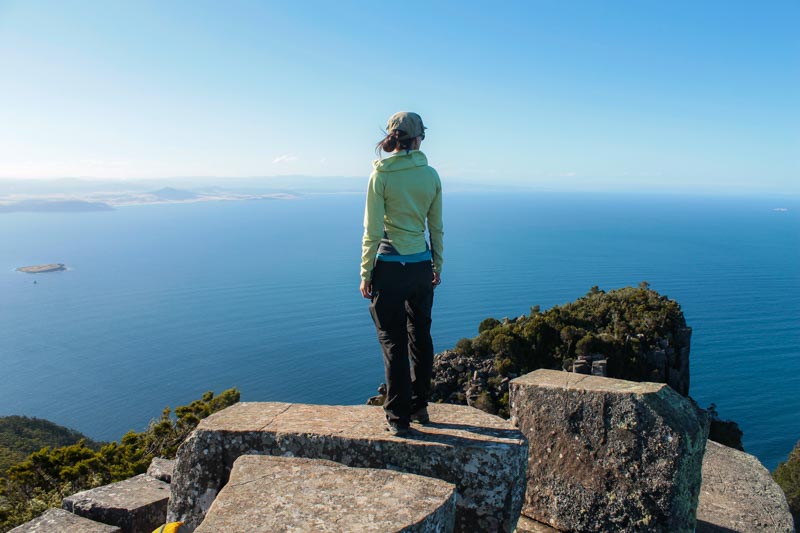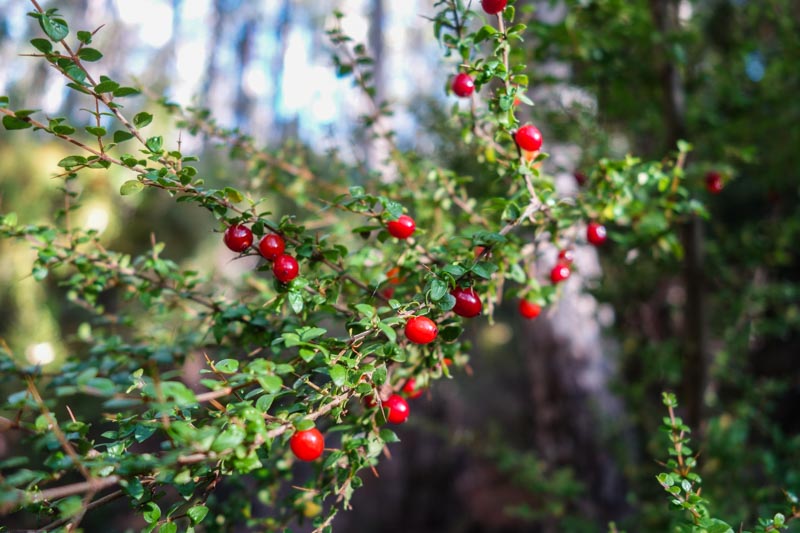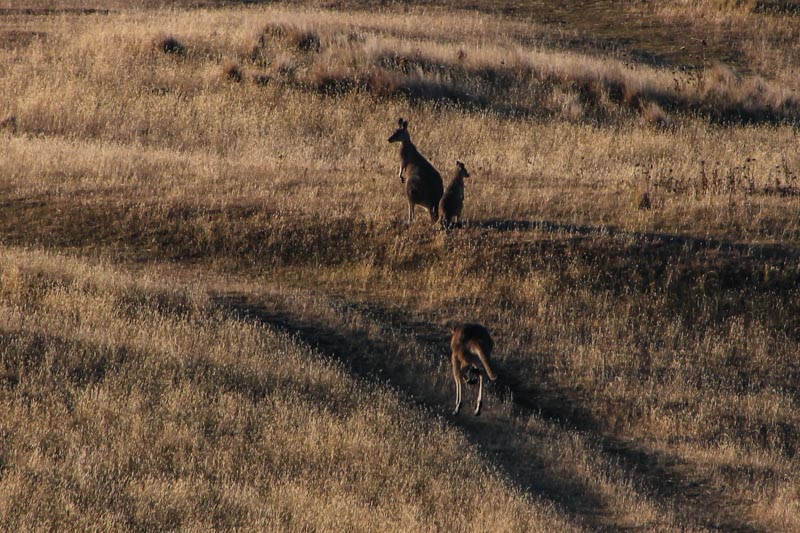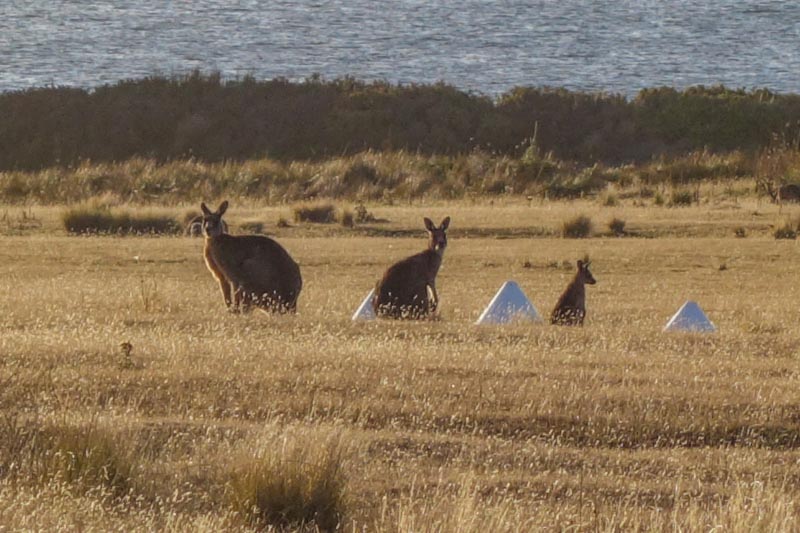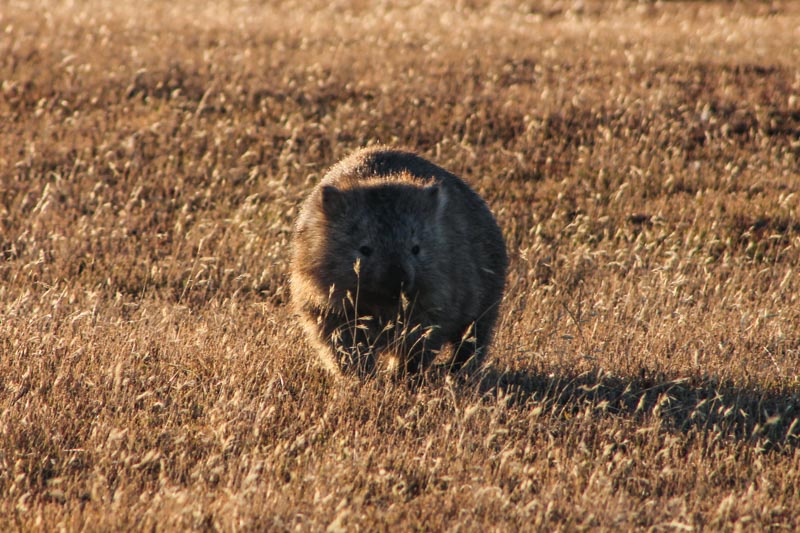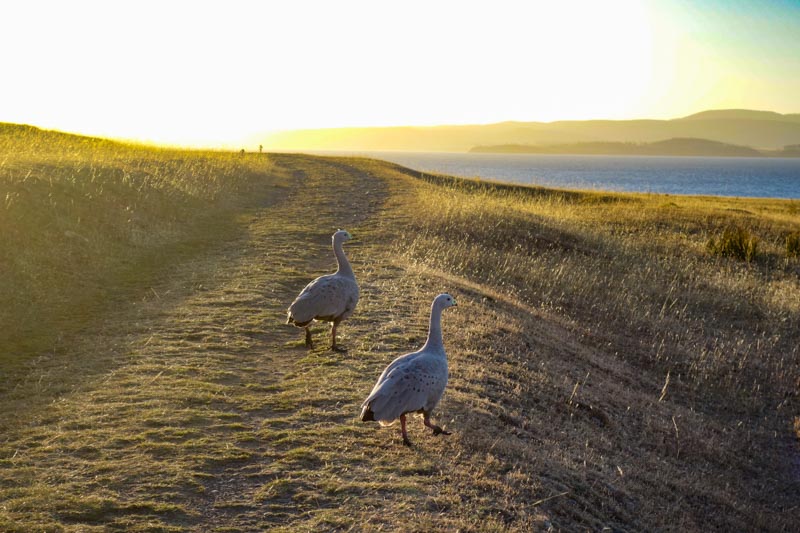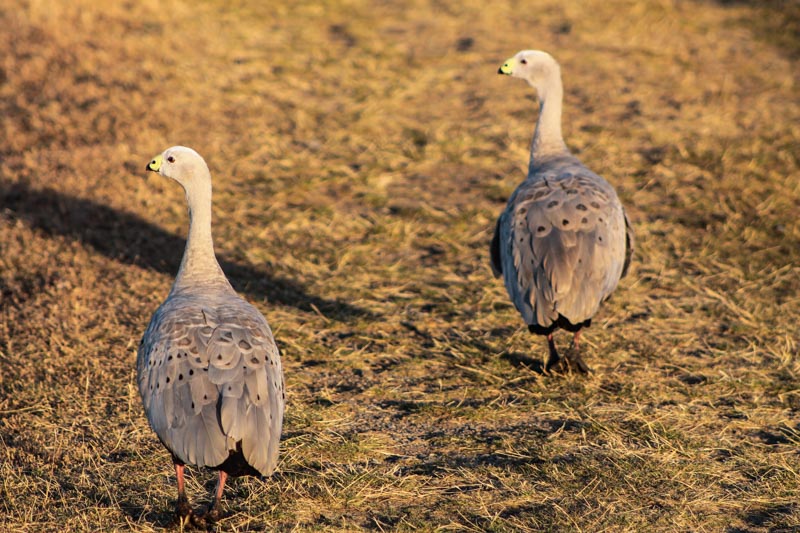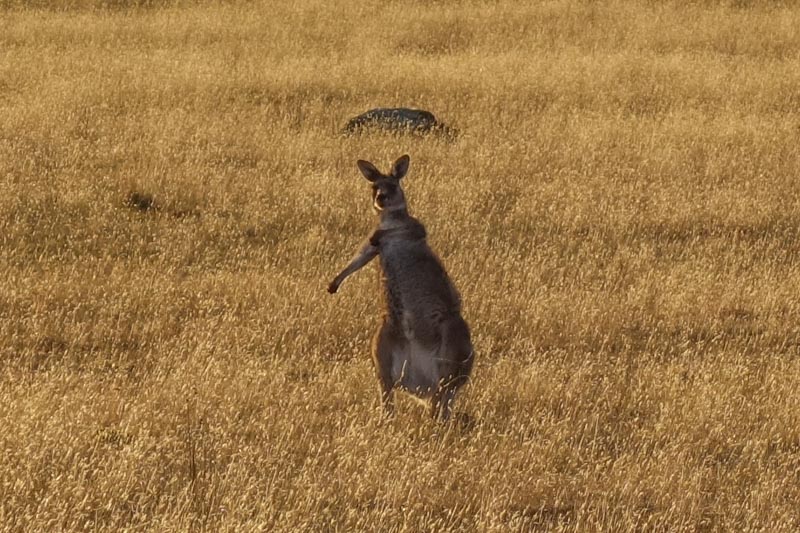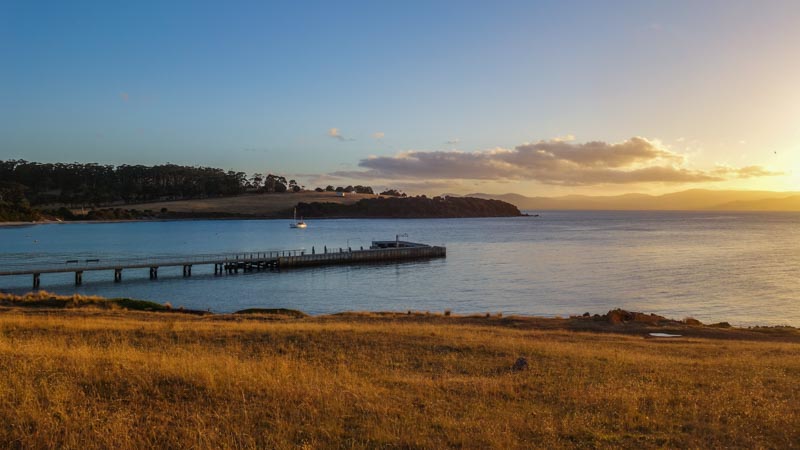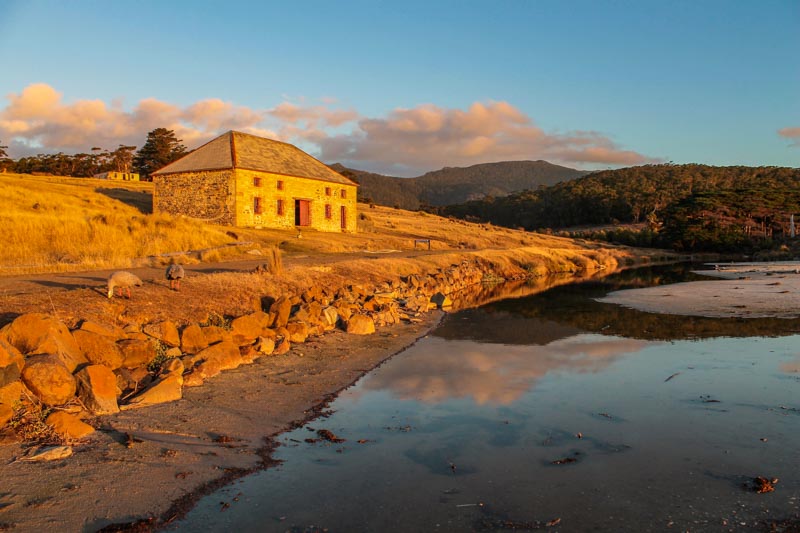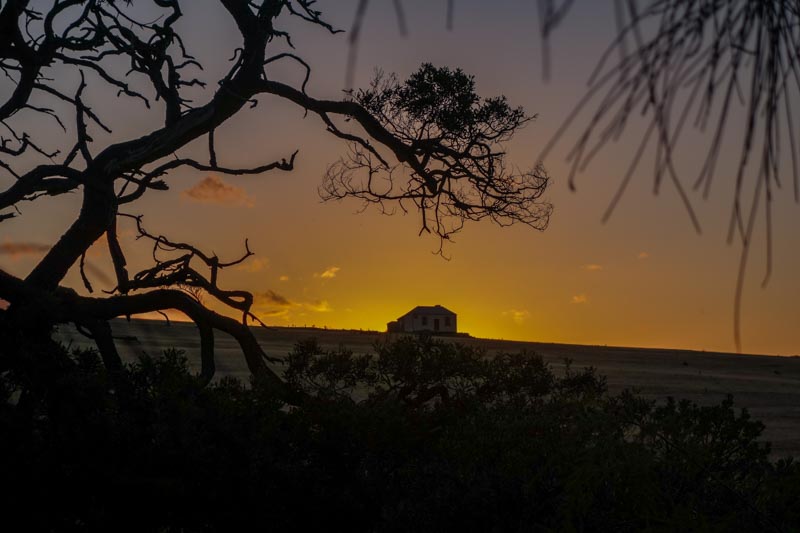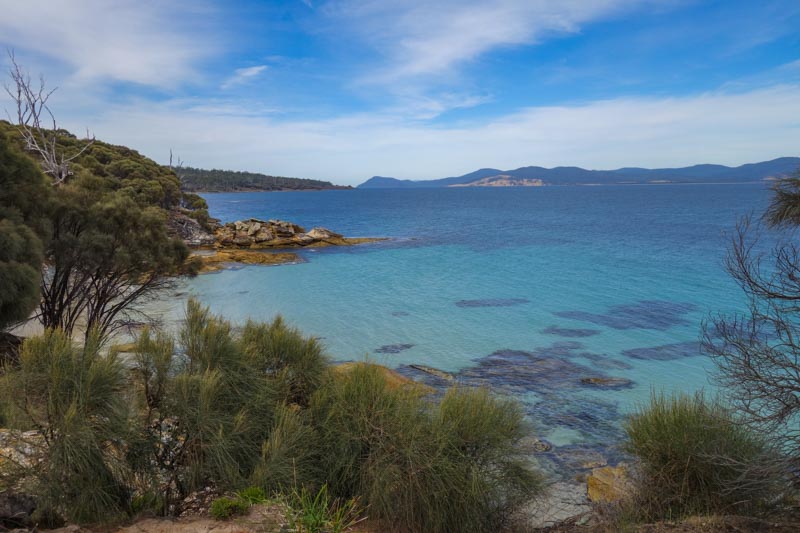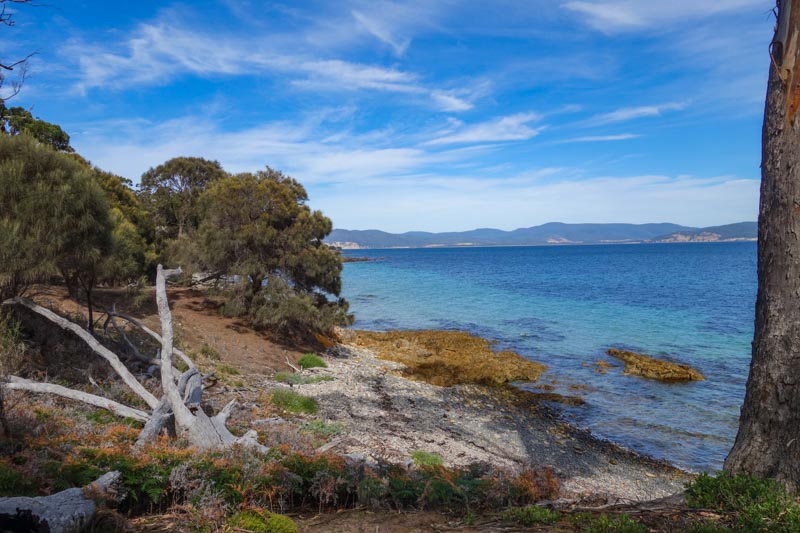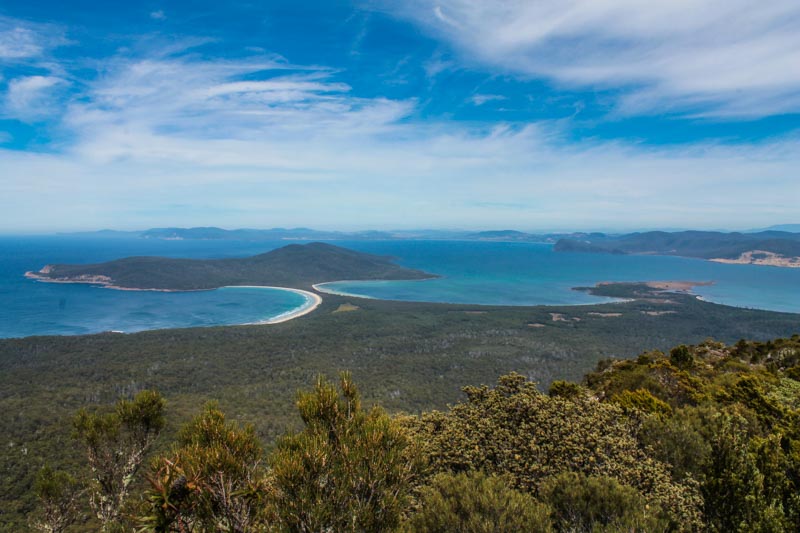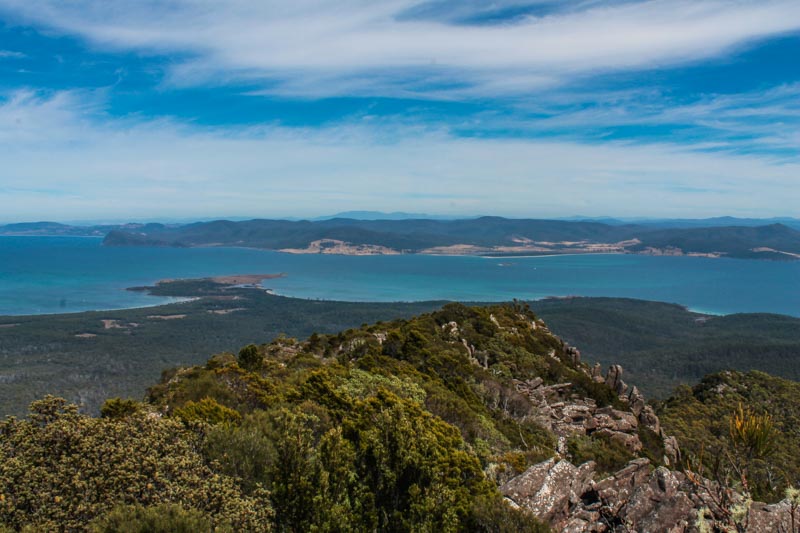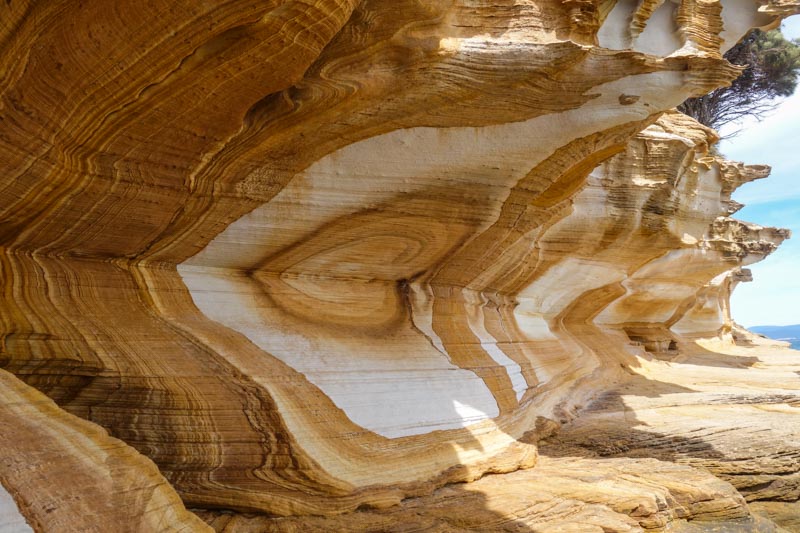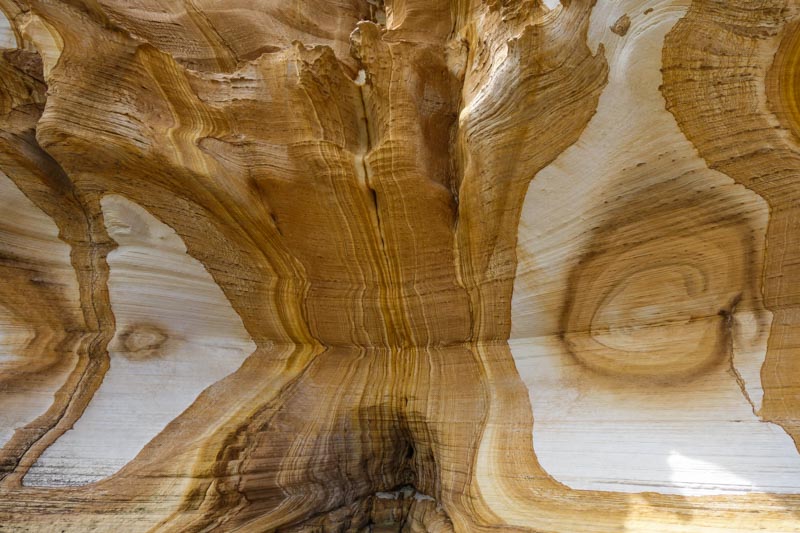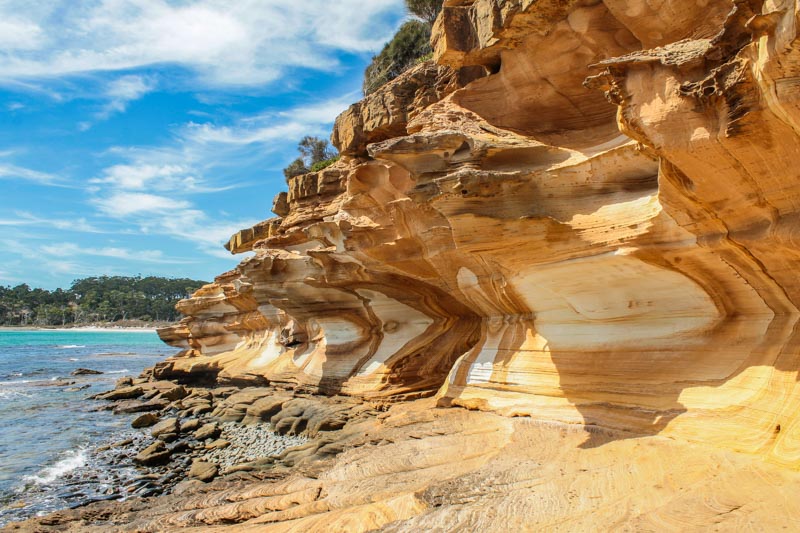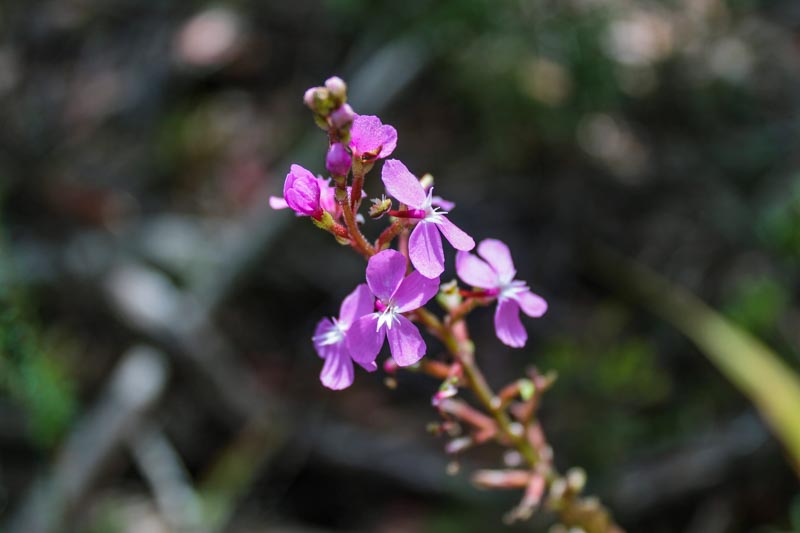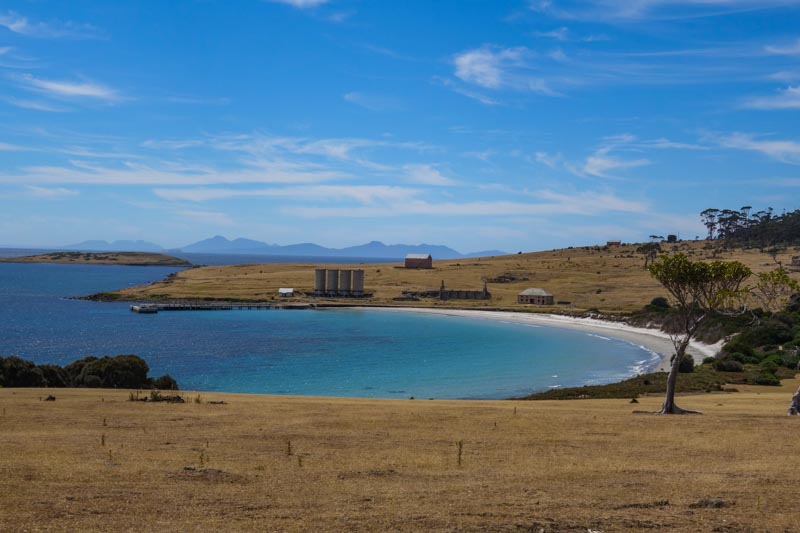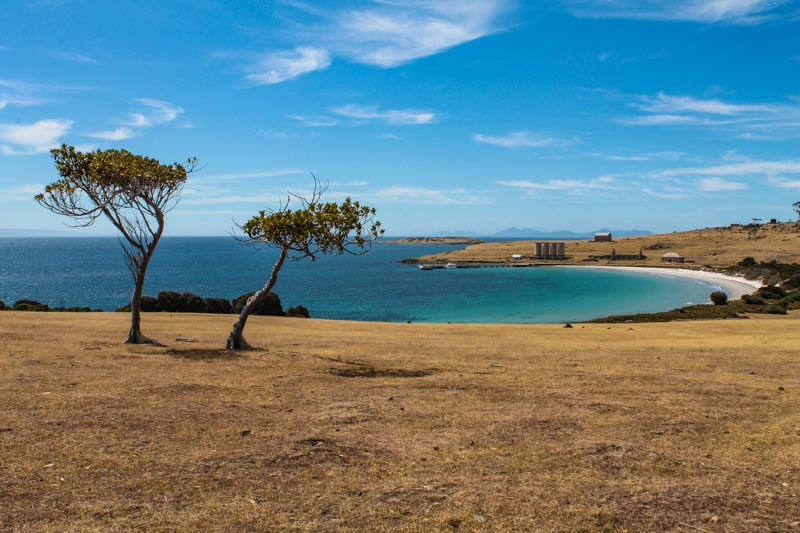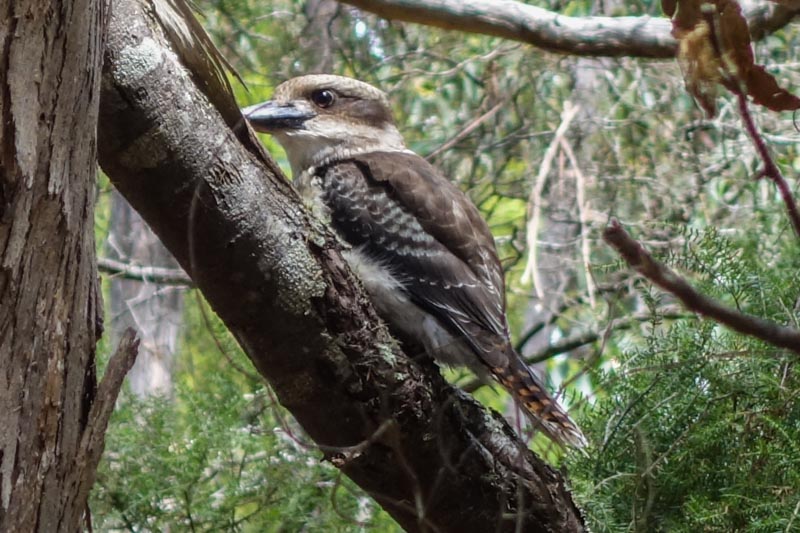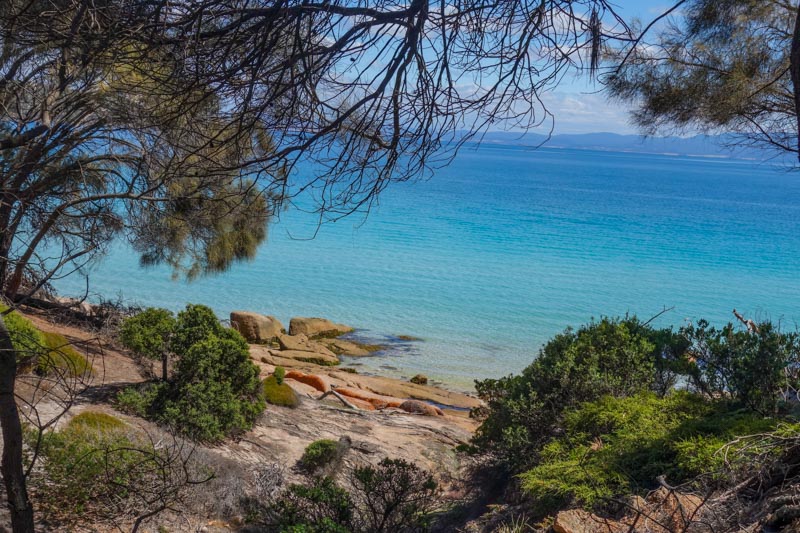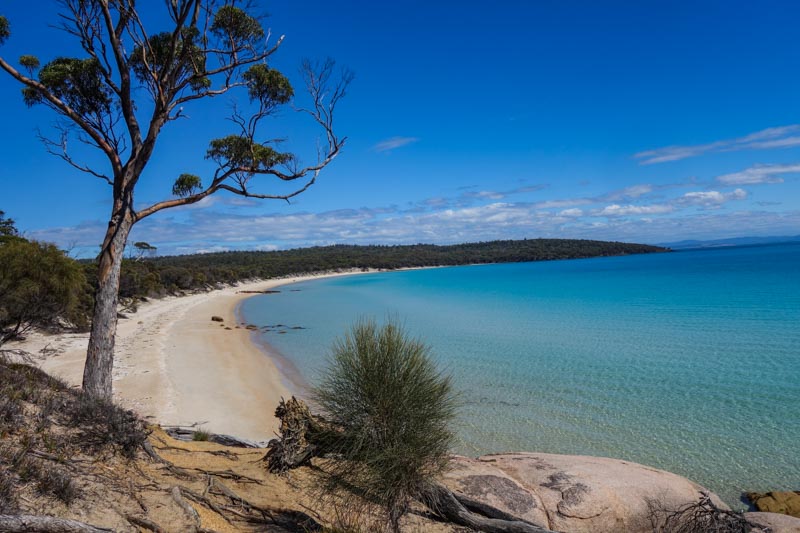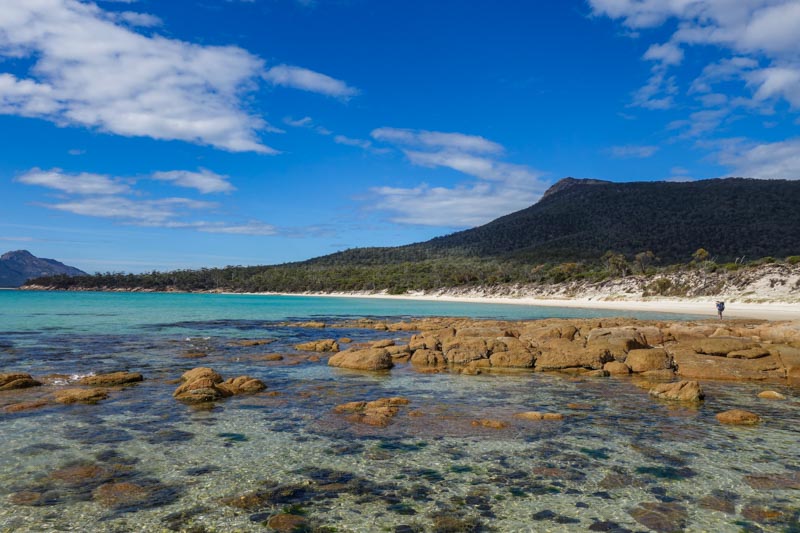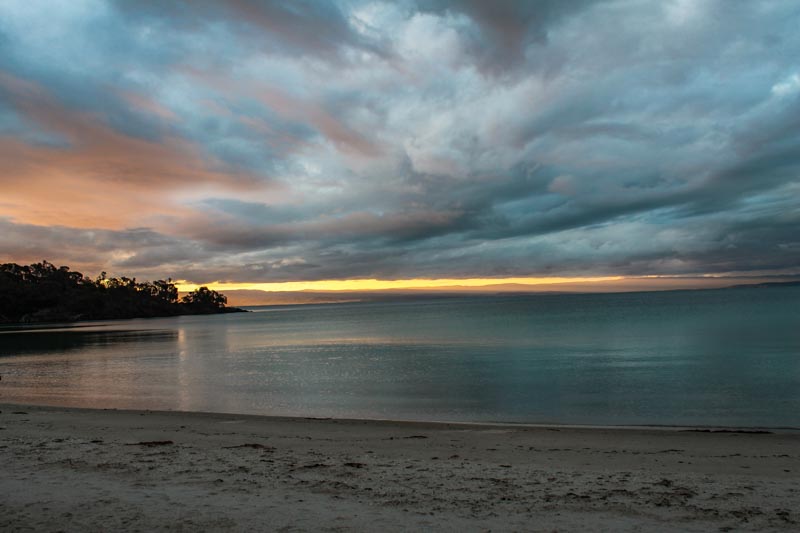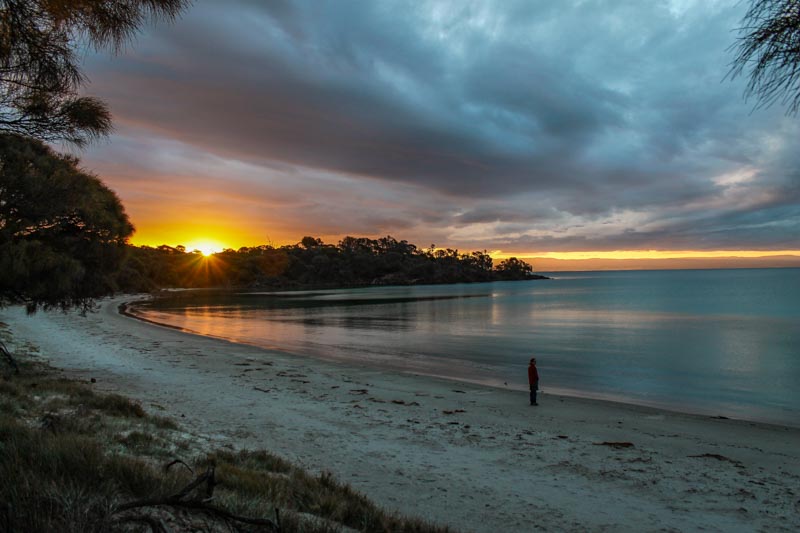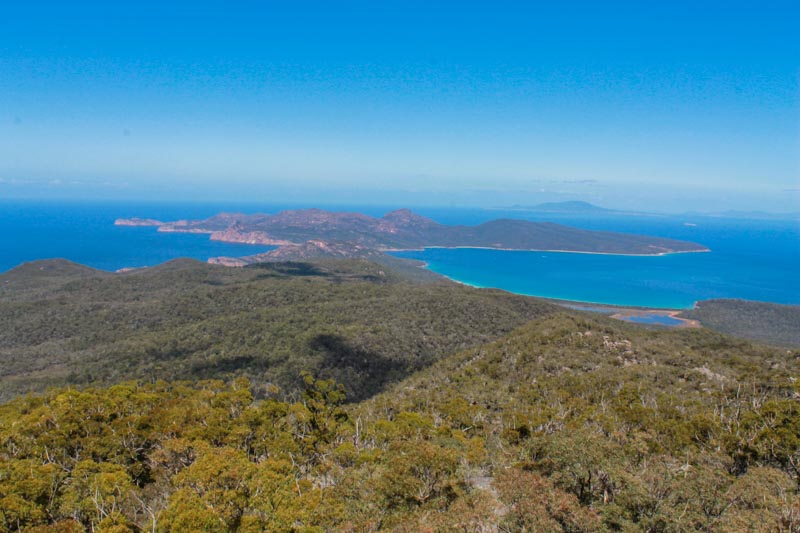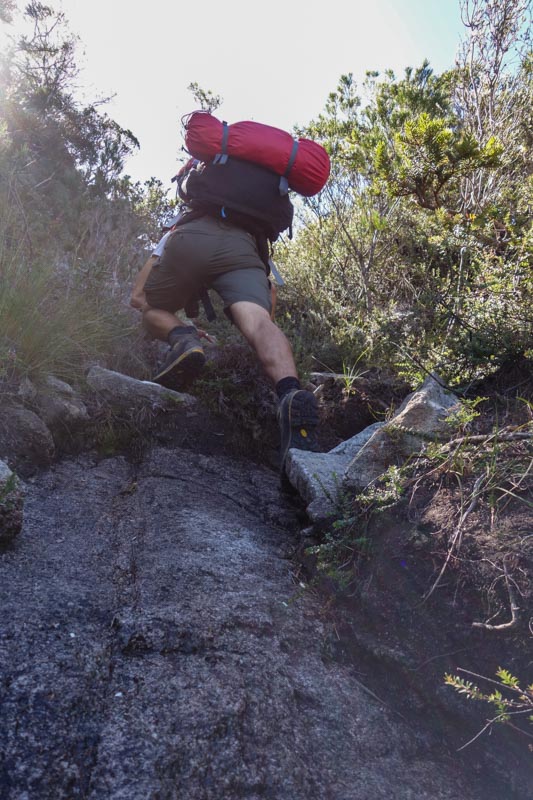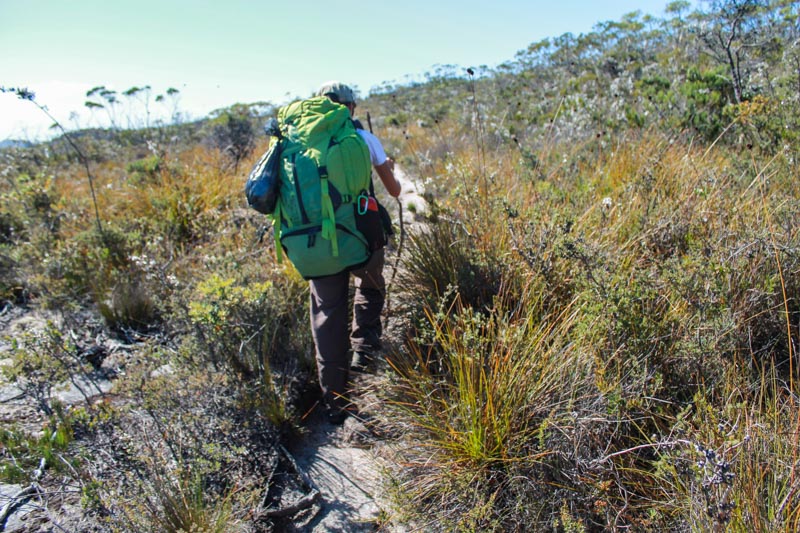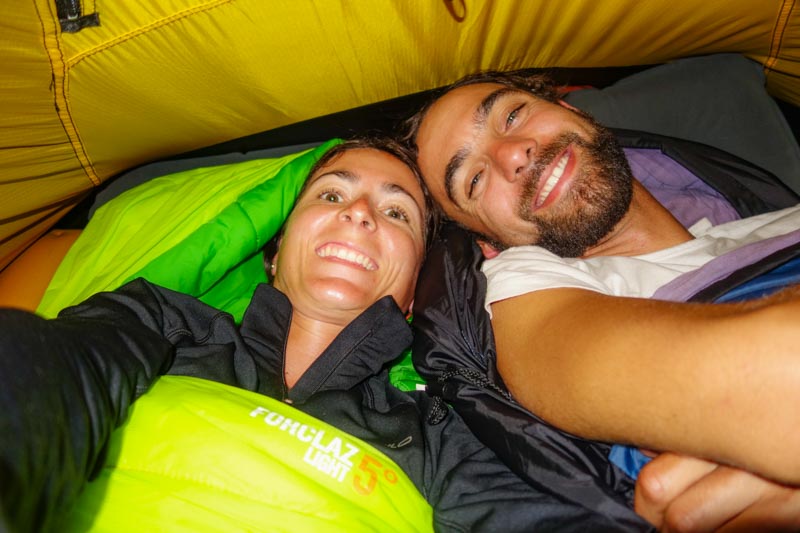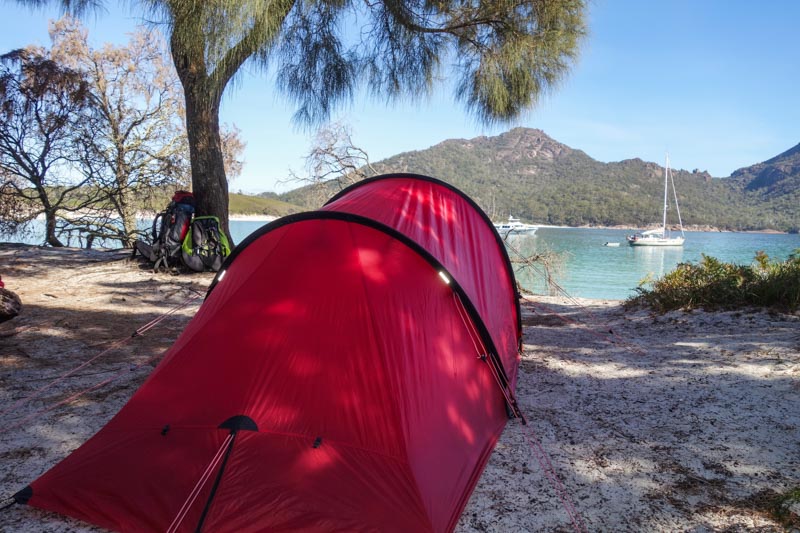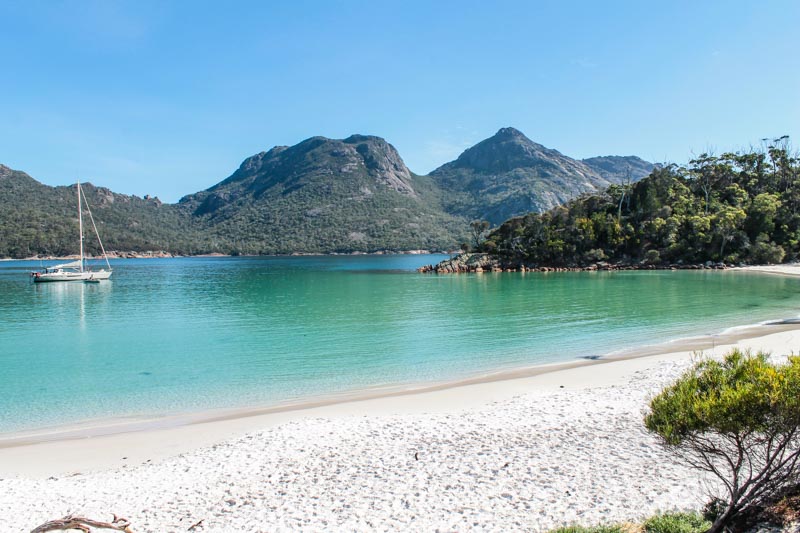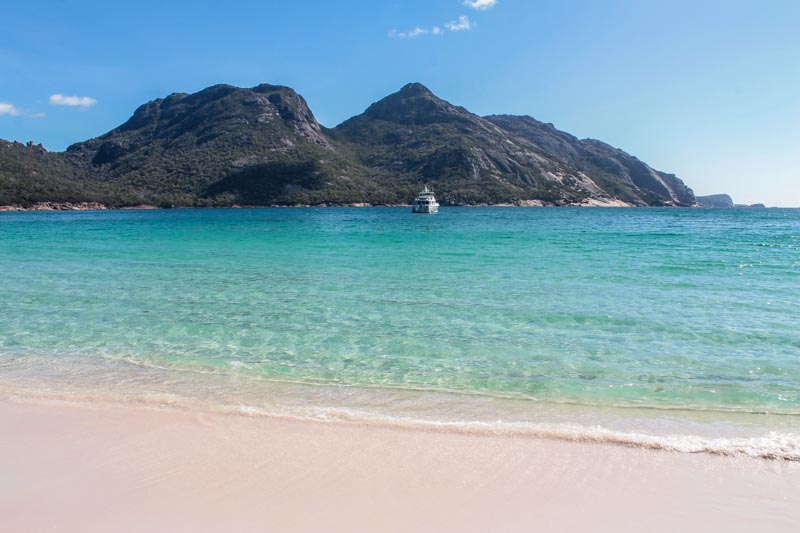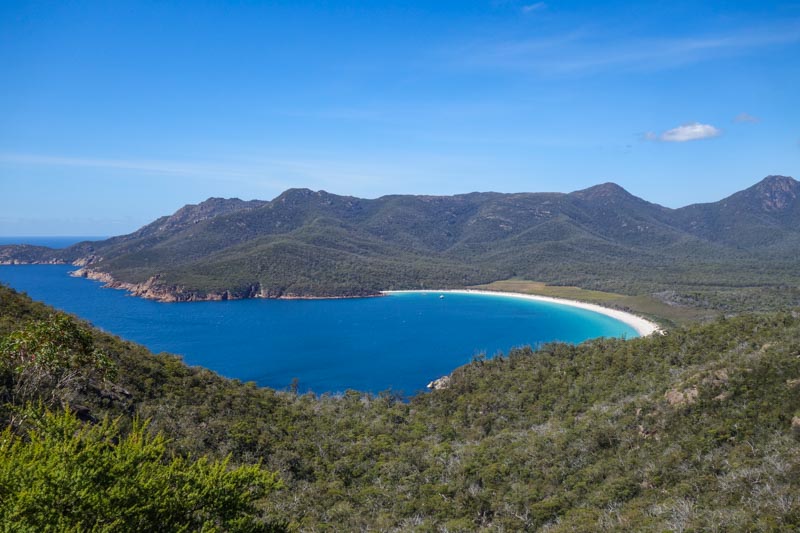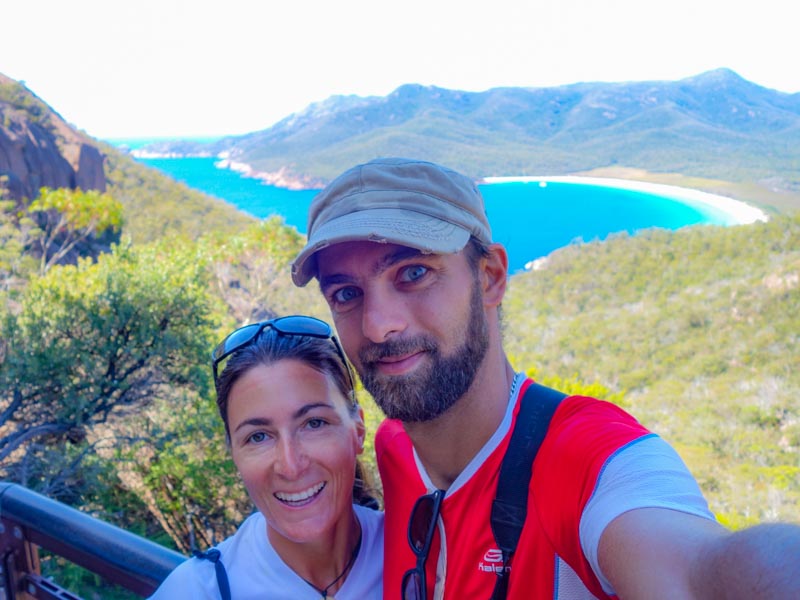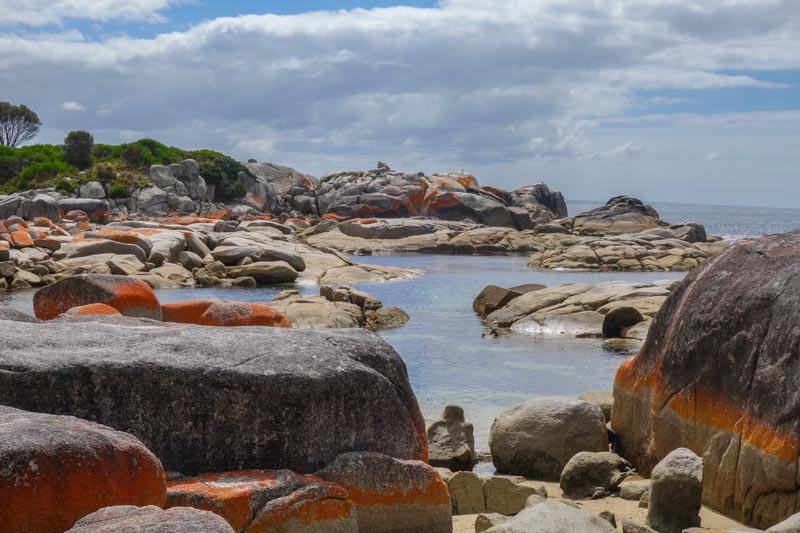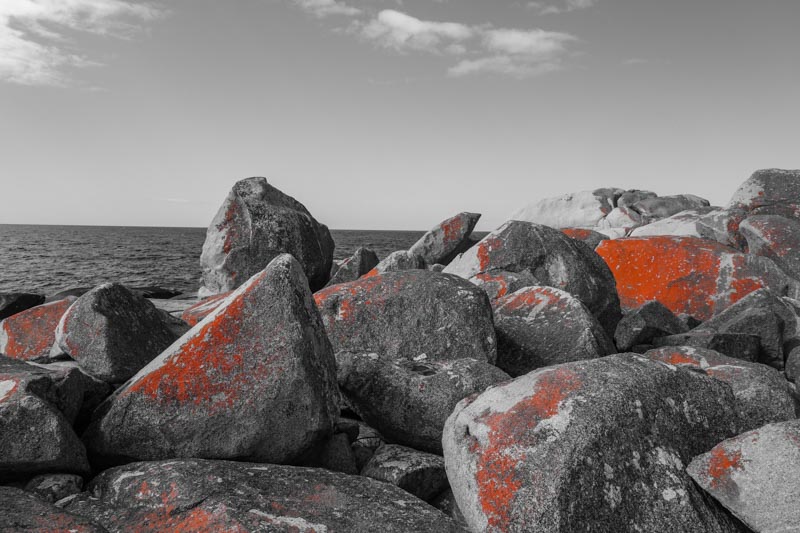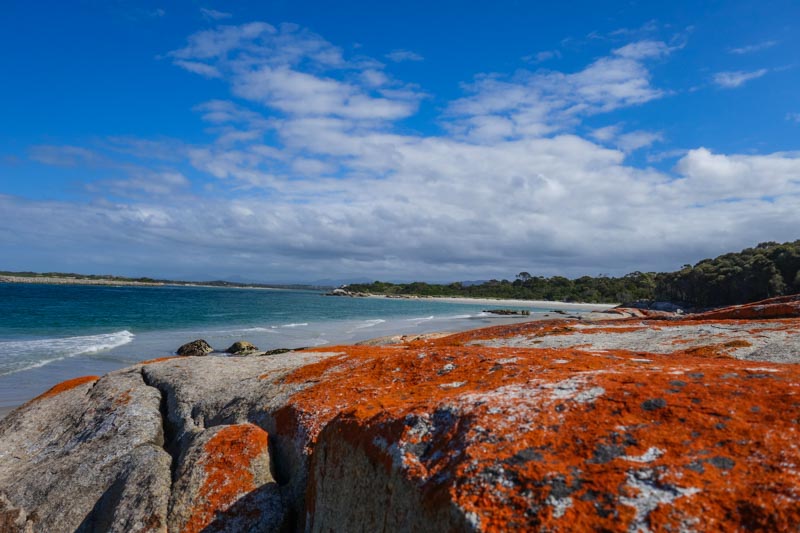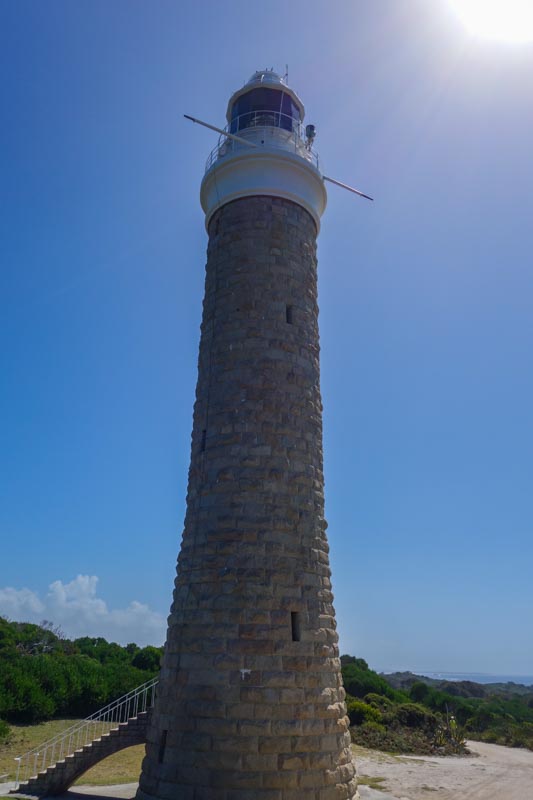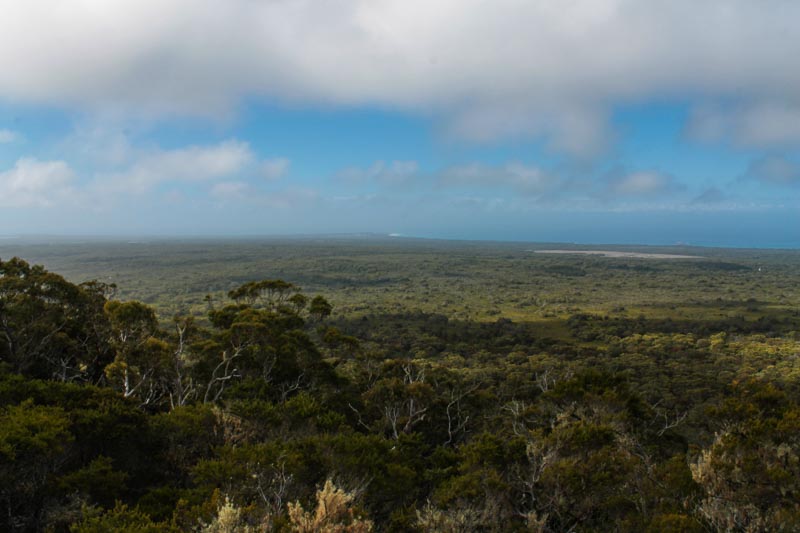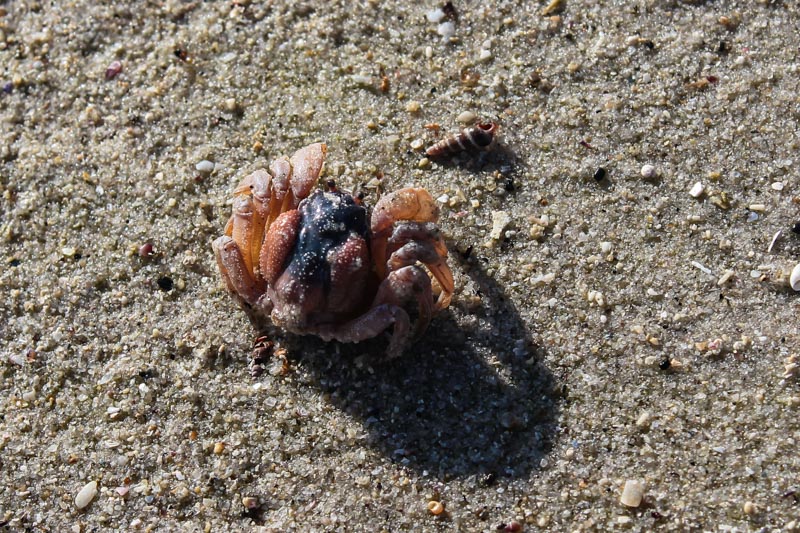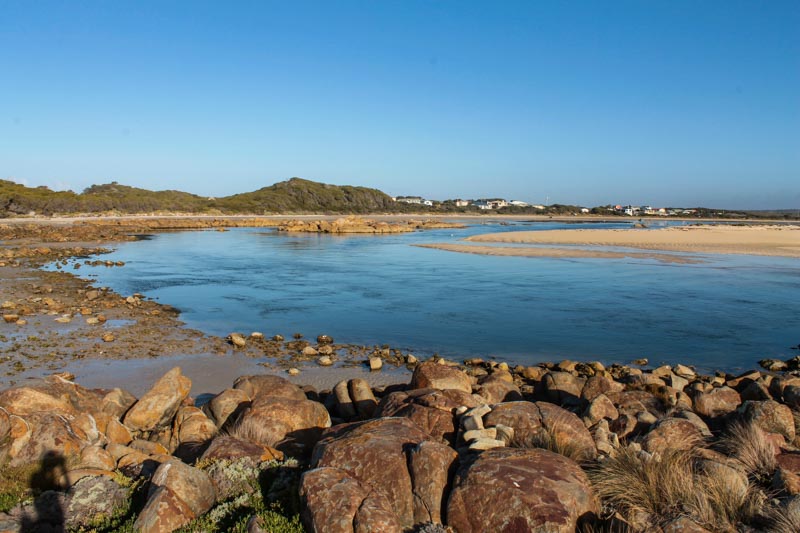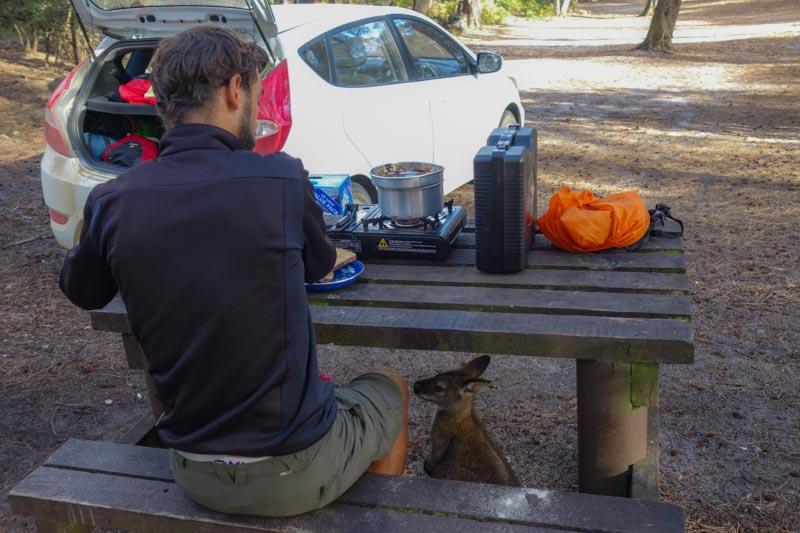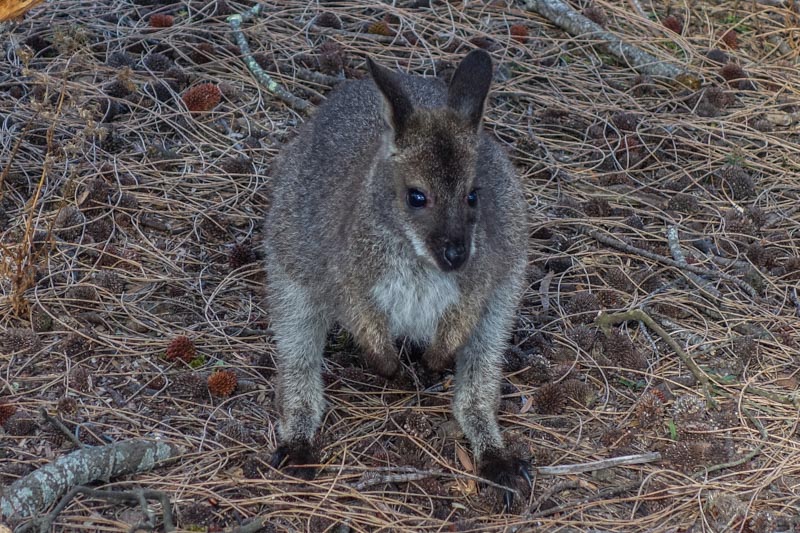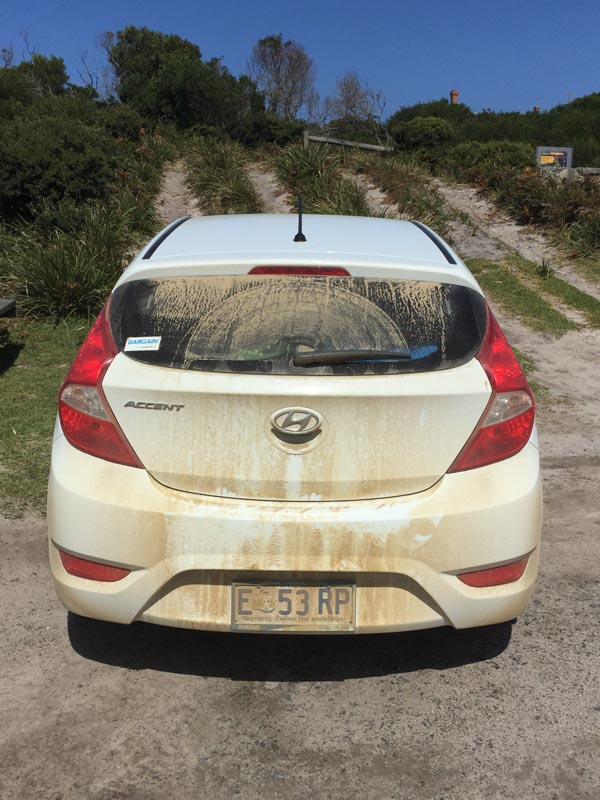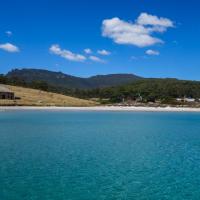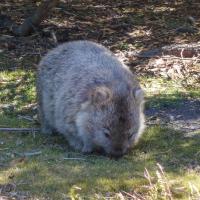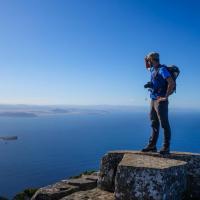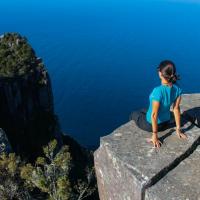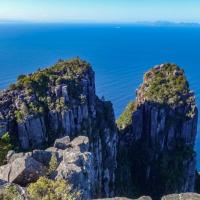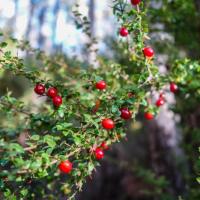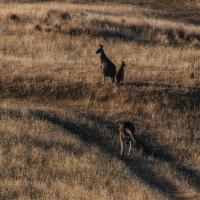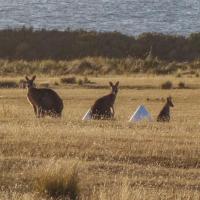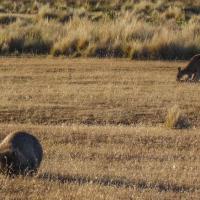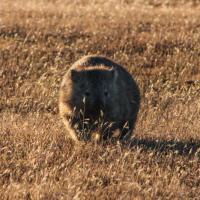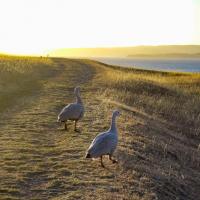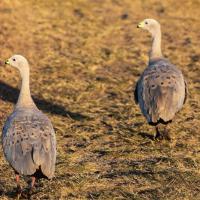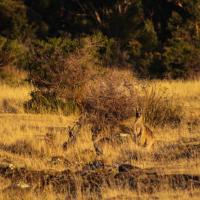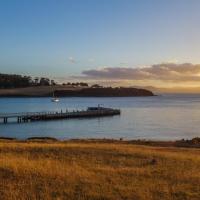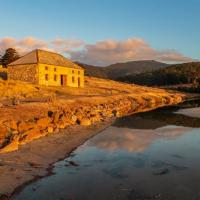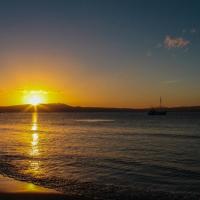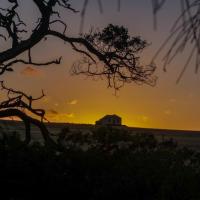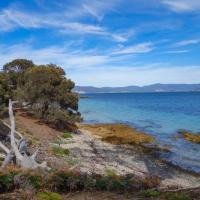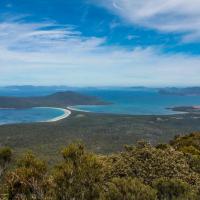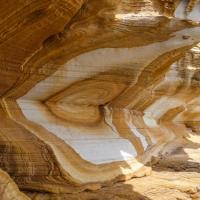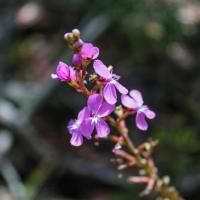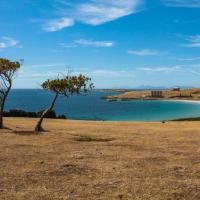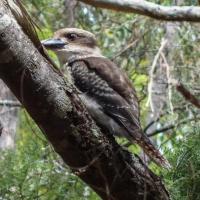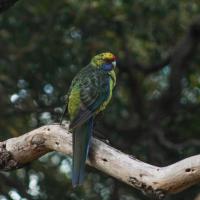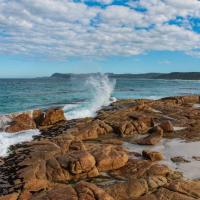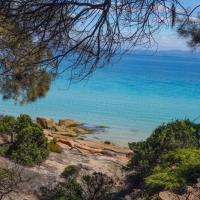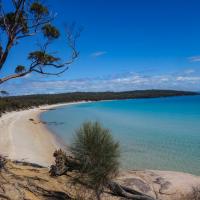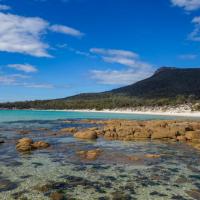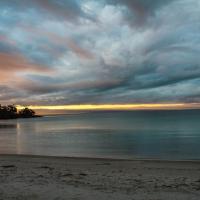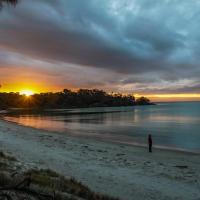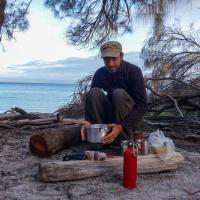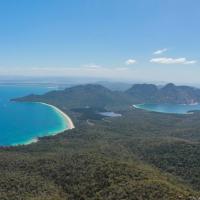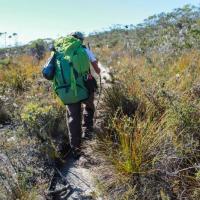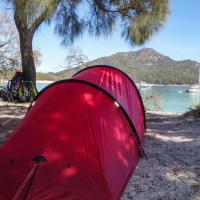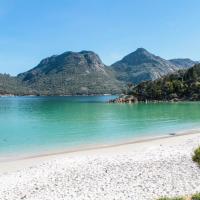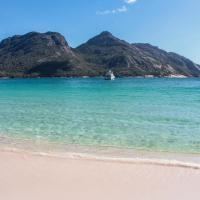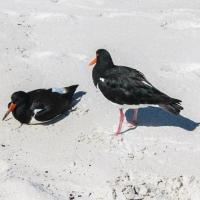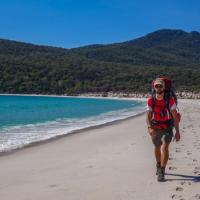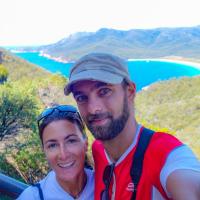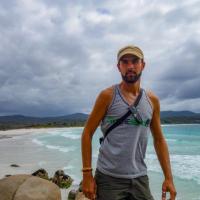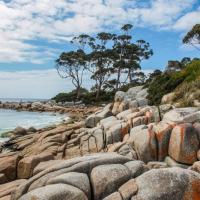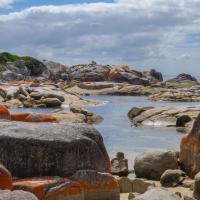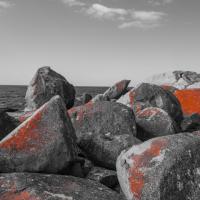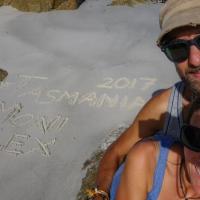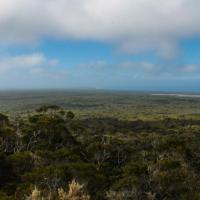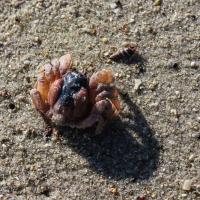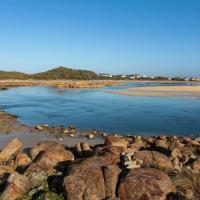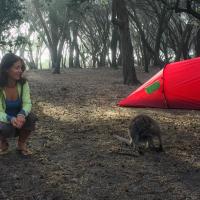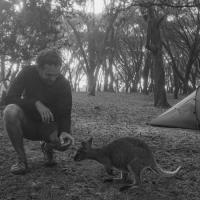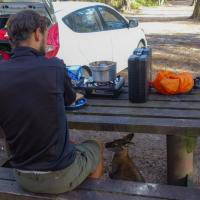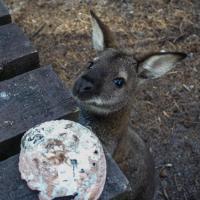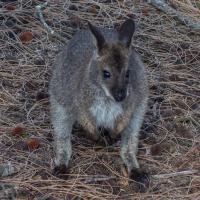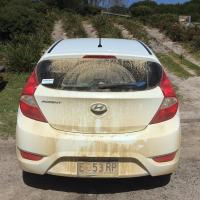Maria Island
Oh, beautiful Maria Island!! From Triabunna, we took the midday ferry and as predicted by the weather forecast, we arrived on the island with sunshine and blue sky in the early afternoon. We had decided to spend the night there and thus brought all our camping gear over. We stayed at the campground in Darlington, next to the ferry pier. Maria Island is a car-free island without any paved roads, only dirt roads and tracks are leading hikers and cyclists around the island. When we crossed the campground to look for a nice spot to set up our tent we were stumbling across our very first wombats. Really big and healthy looking, fluffy wombats, looking like big grey hamsters. We pitched our tent and profited from the beautiful weather to go hiking.
That afternoon we hiked up to Bishop and Clerke (620m), a small and windy plateau with an almost 360 degrees view of Maria Island and the surrounding peninsulas. We started walking through lush forests and saw many native cranberry trees, but did not dare to eat them as we were not sure they really were cranberries. The last part was a bit more strenuous and we had to climb over stones, rocks and boulders. The very last 5 minutes up to the viewing plateau we had to do proper rock climbing to reach the top. On such a clear day, the views were simply amazing: we saw the mainland and Triabunna, the Tasman Peninsular and even the Freycinet Peninsular, our next destination. We hiked back down and continued on another loop to the Fossil Cliffs to see some million-year-old fossils in the sandstone.
On the way back to the campground the sun started to set and it was dinner time for all the animals. On the large grassy area of the airfield we saw hundreds of kangaroos, some Grey Barren geese and lots of wombats. It was quite difficult though to differentiate wombats from little rocks or bushes - if it was moving, it was a wombat :). We stopped at Darlington to watch the final sunset and then headed to our tent to cook a hot dinner and tea. While the noodles were boiling a few wallabies were hopping through and once it got darker we even saw a Tassie Devil galloping through the camp. After dinner, a massive opossum came wandering around the table and the devil came running back. As it was getting colder we got ready to sneak into our sleeping bags.
The next day at breakfast we saw yet another wild Tasmanian Devil, this time a juvenile one that was hanging around the trees at the end of the campsite. We still had a full day to explore the other side of the island and as Alex was keen on climbing Mt. Maria (710m), we decided to split and meet at the campground later on. Moni strolled along the West Coast of Maria Island passing many beautiful bays and seeing lots of cute and hungry wombats. And at the end both of us stopped at the Painted Cliffs, beautifully sculpted sandstone cliffs, stained with iron oxide in amazing orange colours. And at 16:00 it was already time to take the ferry back to Triabunna. We were positively surprised by the untouched beauty of Maria Island and did not regret staying overnight.
Freycinet Peninsular
From Triabunna we drove north, direction our next destination: the Freycinet Peninsular. We had a relaxed day with some stops at an organic berry farm and two wineries. Especially the wines at Devil's Corner impressed us a lot, so we bought two bottles (what else). In terms of red wine, Pinot Noir is the most common grape in Tasmania, in terms of white wine we loved the style of the Tassie Sauvignon Blanc which smelled and tasted extremely fruity (passionfruit!). In the late afternoon, we arrived on the peninsular and visited the information center to get hiking maps and useful tips for our planned 3 days hike. Then we set up our tent at the free campsite "Friendly Beaches" where we happily shared our spot with Radek, a nice and funny Polish guy who was travelling around Australia on his bicycle.
During the night, we had heavy rain and unfortunately had to pack a wet tent the next morning, not the best considering that Alex had to carry it. It was still drizzling when we started our hike from the Wineglass Bay carpark, but as predicted by the weather forecast the rain stopped at midday. By the time we had reached Hazards beach, a 3km stretch of white sandy beach that we had to cross. Walking on sand is generally a bit strenuous, but did you ever try with a huge backpack on your back?! Not fun ;)! After Hazards Beach, we had to walk through the forest to reach Cooks Beach where we would spend the night. It was as if we were walking into a black hole - on one side it was grey and windy and the rain had just stopped and when we exited on the other side it felt like we had landed on a small Caribbean island. Sunshine and blue sky, calm and crystal-clear turquoise water and a white sugar beach. In a good mood, we put our tent into the sun to dry and explored the area a bit. We spent a lazy afternoon at the beach and made friends with a nice Australian couple (Kelly and her husband) from Sydney. We enjoyed a beautiful sunset, cute wallabies and as we had brought our cooking equipment and food for 3 days we cooked a hot dinner before going to bed.
The next day we got up early as we had a big day ahead of us! At Cooks Beach there were 2 water tanks, one with drinking water and one for washing and cooking. As we knew that at the next campsite there would be no water supplies and we could not rely on creeks, we had to bring water for drinking, washing and cooking with us for the next 1,5 days. Poor Alex was carrying 5 of the 6 liters we brought along and we left the camp to cross the mountains of the peninsular to reach Wineglass Bay on the other side. And it was a tough day! The first part of the trek was moderately ascending through cool forests, then we reached the turn-off to Mt. Freycinet (620m) and dropped our backpacks to hike up without the weight on our shoulders. It was tough climbing, but the views on that clear and sunny day were stunning. We had a 360 degrees view of the peninsular, saw down to Harzards Beach, Cooks Beach and beautiful Wineglass Bay on the other side. We could even make out Maria Island far in the south! Back down, we picked up our bags and then the hard part started. The ascent to Mt.Graham (579m) was rough terrain with a small and steep rocky path, sometimes we had to climb up stone walls on all 4. The path would have even been challenging without backpack, but carrying all our supplies made it even harder. On top of Mt. Graham we were again rewarded with beautiful views of Wineglass Bay. It got its name for 2 reasons: first of all, it is perfectly shaped like a wineglass and secondly, back in the old days the whalers used to slaughter the whales in this bay and all the blood made it look like a full glass of red wine from above. Terrible story for such a beautiful place!
The rest of the afternoon was downhill hiking, but Moni's legs were already quite tired, so it was not too easy neither. We finally arrived down at the beach of Wineglass Bay and pitched the tent under some trees with views of the bay. We enjoyed the rest of the evening sun at the beach and Alex was even brave enough for a swim in the chilly water. Once the sun set and it was cooling off we had dinner and got ready for bed. We'll probably remember this night at Wineglass Bay forever :). As we were in a National Park the rule was "whatever you carry in, you carry out!" So we had a bin bag with garbage of the last two days with us. For the smell, we did not want to take it into the sleeping compartment with us and thus left in in the awning. Just when Alex was falling asleep he heard some weird scratching sounds from the front of the tent and got up to check. He saw a wallaby putting its nose and claws underneath the main tent, trying to get hold of our garbage. He scared it away and decided to put the bin bag outside the tent high up in a tree where the wallabies could not reach it. Well, what we did not think of were the opossums around that can easily climb trees and were equally interested in our food scraps. The next morning, we had two nice surprises: the bin bag was completely torn apart and all our garbage the animals were not interested in was spread around the area (we of course collected it and brought it back with us). And as we still had some food for breakfast in an isolation bag inside Alex' backpack (those beasts probably smelled it) an opossum must have sneaked inside the tent to look for it. When it realized that it could not access the food inside the backpack... it shitted on Alex' backpack :)))))!!! Luckily, its faeces were round and hard and we could remove them quite easily without marks or smell on the backpack. At the end, we were laughing really hard about this incident.
The next morning was sunny and warm as well and we set off for the last part of the journey, crossing Wineglass Bay and hiking back up to the carpark. Once again, we had to walk on soft sand and were already exhausted when we reached the path leading up. As there are many day visitors coming down from that side, at least the path was well maintained and we hiked up to the viewpoint quite quickly and then back to our car. As a reward, we had a big lunch and a glass of wine on the terrace of a superb restaurant before carrying on north.
Bay of Fires
We spent the night in St. Helens at a proper campground as we urgently needed a shower and doing some laundry. The next morning, we took it easy and got some maps and recommendations for Bay of Fires at the information center. Then we drove the narrow road up to Binalong Bay, the main village and holiday resort around Bay of Fires. We checked out the beach and then went on two short hikes around Skeleton Point and Dora Point, both with stunning views of the Tasman Sea and many of the famous orange-hued granites around. The orange colour is coming from a lichen that covers the rocks in its bright colour, you will clearly see it on the pictures. Around Binalong Bay there are a few free campsites and we set up our tent in a cozy corner in between two beautiful sugar white beaches at Jeanneret Beach. We enjoyed the breeze of the sea at the beach in the evening and in the early morning the next day.
Binalong Bay and its surrounding beaches is what is overall associated with Bay of Fires, though it goes much further north. So we took the gravel road that was leading us all the way up to Eddystone Point with its lighthouse on Aboriginal land and to Mt. Williams, which is more of a tiny hill than a mountain, but we still climbed it ;). We also went further north to an Aboriginal village in Musselroe Bay. On the way back to our campsite in Stumpy Bay we saw tons of kangaroos and wallabies on the grassy areas looking for food. We could never get sick of seeing those cute animals with their big black eyes. Apart from another car we had the sheltered campsite in the National Park for ourselves. Only the next morning we got company from a wallaby family. The male was not shy at all and was very keen on seeing what we had for breakfast and if he could maybe beg for a bit of food. He was trying hard and even though it was sometimes hard to resist their cute looks, we did not feed him. Finally, he gave up and tried to amuse himself with his female companion instead. She would not let him, so at the end he must have been quite frustrated and decided to lay down and take a rest. The tiny baby wallaby was meanwhile eating in the bush.
And then it was again time to move on. We were heading towards Launceston, a town in northern Tasmania, passing by the Tamar Valley which is big in the production of excellent sparkling wine. If you want to know more about the wine region, Launceston and the beautiful western part of Tasmania, stay with us and wait for the next article.
Cheers from the Andes and see you very soon,
Alex & Moni
 Hi Mama!
Hi Mama! Meine Lieben,
Meine Lieben, Ich weiß, Tasmanien war der absolute Traum, vor allem bei dem sensationellen Wetter. Wäre auch was für die Familie wenn die Maus alt genug ist ;). Strände, Tierchen und viiiiiiiiel gutes Essen
Ich weiß, Tasmanien war der absolute Traum, vor allem bei dem sensationellen Wetter. Wäre auch was für die Familie wenn die Maus alt genug ist ;). Strände, Tierchen und viiiiiiiiel gutes Essen
 Die Fotos sind ein Traum!!! Die Strände sind ja alle wundervoll, aber die Steinformationen gigantisch. Hut ab, dass du dich an die Kante des Felsens setzen getraut hast - ich wäre vermutlich vor lauter Höhenangst runtergekippt XD
Die Fotos sind ein Traum!!! Die Strände sind ja alle wundervoll, aber die Steinformationen gigantisch. Hut ab, dass du dich an die Kante des Felsens setzen getraut hast - ich wäre vermutlich vor lauter Höhenangst runtergekippt XD

